Descriptive Statistics – Summary of Data Collected
16 of our local beekeepers provided me access to weigh 127 of their hives. In total, 208 measurements were taken and the results are given in summary form below; this is the raw data. The measurements were taken on 11/30, 12/1, 12/2, 12/8, 12/9 and 12/15 of 2012. As of now I have no more plans to include more samples, although one colony I will continue measuring weekly; one of our members lives very close to me!
| n (# of samples) | x̅ (average) | std (standard deviation) | |
| Front measures | 79 | 43.46 lbs | 15.26 lbs |
| Back measures | 57 | 49.20 lbs | 15.51 lbs |
| Left measures | 36 | 53.16 lbs | 17.74 lbs |
| Right measures | 38 | 53.15 lbs | 18.04 lbs |
So, what do these measurements say about total hive weight? For now, it is reasonably safe to double the measured left and right weights. The front and back weights are a bit trickier (see below). I am still working on the process of calibrating the weighing device (120+measurements for that alone so far) to get a better understanding of what these numbers actually mean.
Conclusion 1 – These bee colonies are back heavy!
With this data in hand it is statistically easy to demonstrate that the honeybees prefer to put more weight in the back of the colony (away from the entrance) than in the front. This is independent of all the different management techniques of these 16 beekeepers, even that some tilt the colony forward (by putting a wooden spacer under the back) which shifts the weight to the front. Below are two different tests, which together, verify the conclusion that the measured colonies are back heavy.
Test 1. A two-sample t-test can be performed to compare each of the front and back measurements separately. The benefit of this is that it includes the largest amount of samples. The cost of this is that it literally compares the front of some nucs to the back of some 5 box colonies as well as the backs of some nucs to the front of some 5 box colonies. Even given this tremendous variability, the signal is still relatively clear.
From this test it is estimated that the back weighs 5.74 lbs more than the front. For the statistically trained, t = 2.14, p = 0.034, df = 119. For us the p-value is the most important, being less than 0.05. This is what we might call marginally statistically significant. For our purposes however, it indicates there is some difference between front and back measurements, the back being heavier.
Test 2. A one-sample t-test of relative weights can be performed on a calculated measurement ‘B/F’ (back divided by front) of hives in which both front and back were weighed. If back and front are equal, the division would result in a value of 1. If the back is heavier, the division would result in a value greater than 1. If the front is heavier, the division would result in a value less than 1. The benefit of this test is that it tests single hives with themselves only. The cost is that there are fewer samples. The division is used here (instead of subtraction) to make each hive comparable (regardless of their weight) to each other.
First, we use the front weights and back weights to obtain the calculated measurement (back divided by front). When we do this we end up with the following descriptive statistics for 40 colonies that had both front and back measured (notice there are no units because it is now a relative amount).
| n (# of samples) | x̅ (average) | std (standard deviation) | |
| Back/Front | 40 | 1.22 | 0.23 |
Second, we then compare this calculated measurement to the value of 1 to determine if there is a significant difference. The result of this test is that the calculated measurement is significantly greater than 1. For the statistically trained, t = 6.22, p < 0.001. Here the very low p-value indicates that this is a highly statistically significant difference between our measure and the expectation of 1. Again, these colonies are back heavy, with the back weighing about 1.22 times as much as the front!
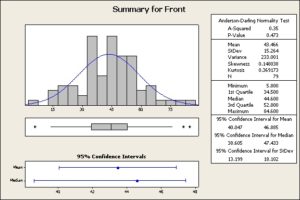 |
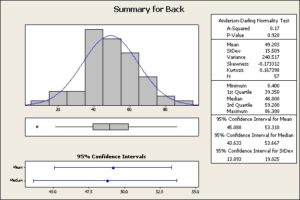 |
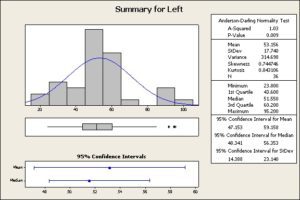 |
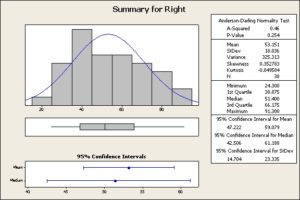 |
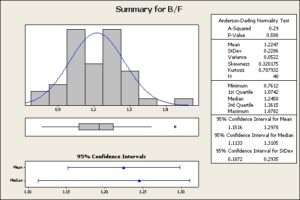 |